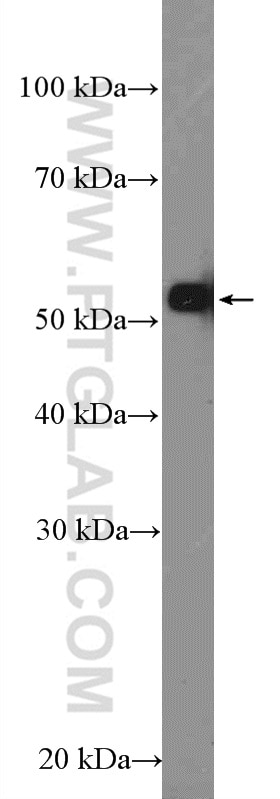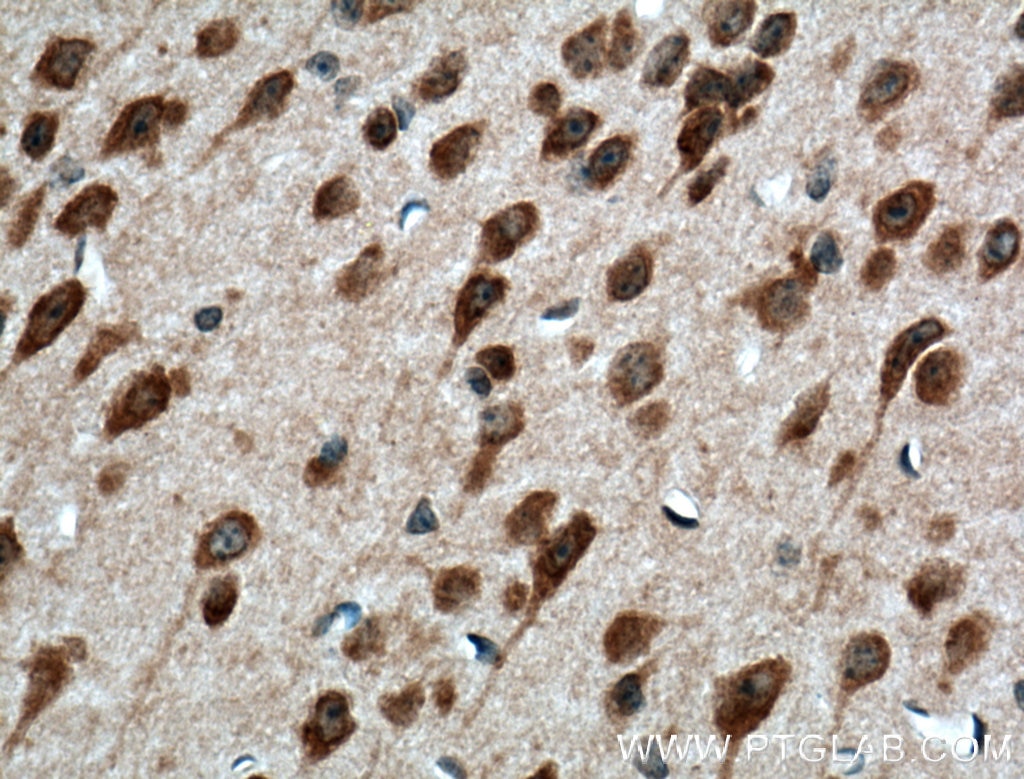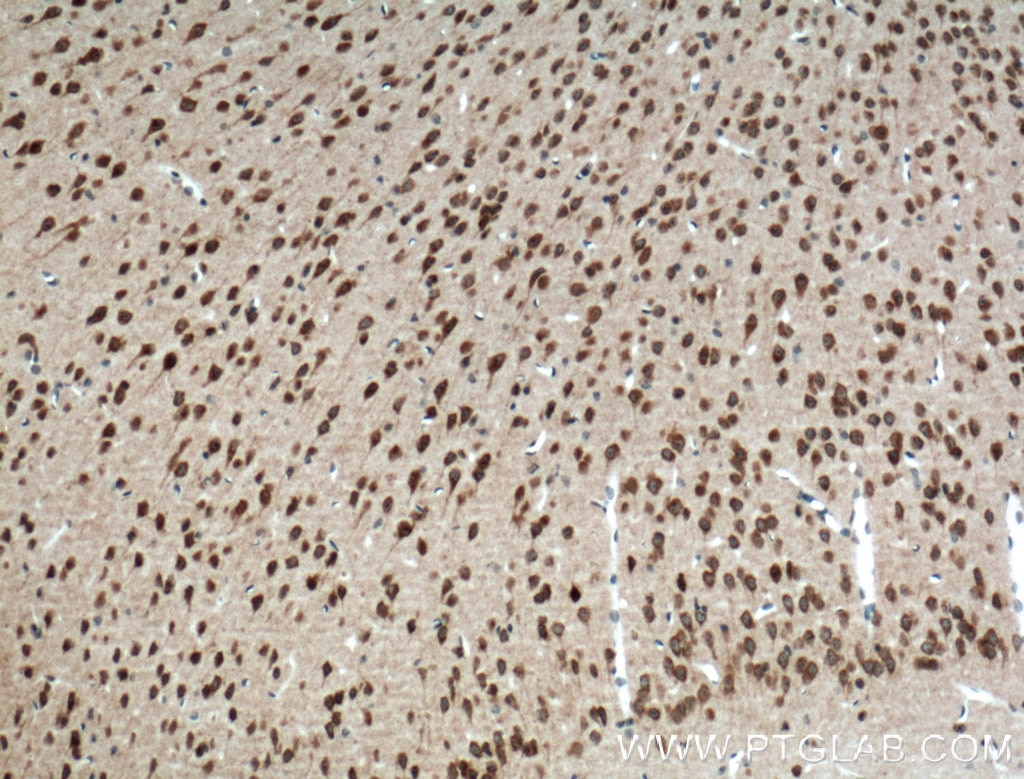Tested Applications
| Positive WB detected in | THP-1 cells |
| Positive IP detected in | SH-SY5Y cells |
| Positive IHC detected in | mouse brain tissue Note: suggested antigen retrieval with TE buffer pH 9.0; (*) Alternatively, antigen retrieval may be performed with citrate buffer pH 6.0 |
Recommended dilution
| Application | Dilution |
|---|---|
| Western Blot (WB) | WB : 1:500-1:1000 |
| Immunoprecipitation (IP) | IP : 0.5-4.0 ug for 1.0-3.0 mg of total protein lysate |
| Immunohistochemistry (IHC) | IHC : 1:50-1:500 |
| It is recommended that this reagent should be titrated in each testing system to obtain optimal results. | |
| Sample-dependent, Check data in validation data gallery. | |
Published Applications
| KD/KO | See 1 publications below |
| WB | See 4 publications below |
| IHC | See 1 publications below |
Product Information
12053-1-AP targets PELI1 in WB, IP, IHC, ELISA applications and shows reactivity with human, mouse, rat samples.
| Tested Reactivity | human, mouse, rat |
| Cited Reactivity | human, mouse |
| Host / Isotype | Rabbit / IgG |
| Class | Polyclonal |
| Type | Antibody |
| Immunogen |
CatNo: Ag2683 Product name: Recombinant human PELI1 protein Source: e coli.-derived, PGEX-4T Tag: GST Domain: 294-418 aa of BC011419 Sequence: MKRKDVVDEKQPWVYLNCGHVHGYHNWGNKEERDGKDRECPMCRSVGPYVPLWLGCEAGFYVDAGPPTHAFSPCGHVCSEKTTAYWSQIPLPHGTHTFHAACPFCAHQLAGEQGYIRLIFQGPLD Predict reactive species |
| Full Name | pellino homolog 1 (Drosophila) |
| Calculated Molecular Weight | 418 aa, 46 kDa |
| Observed Molecular Weight | 46-53 kDa |
| GenBank Accession Number | BC011419 |
| Gene Symbol | PELI1 |
| Gene ID (NCBI) | 57162 |
| RRID | AB_2161180 |
| Conjugate | Unconjugated |
| Form | Liquid |
| Purification Method | Antigen affinity purification |
| UNIPROT ID | Q96FA3 |
| Storage Buffer | PBS with 0.02% sodium azide and 50% glycerol, pH 7.3. |
| Storage Conditions | Store at -20°C. Stable for one year after shipment. Aliquoting is unnecessary for -20oC storage. 20ul sizes contain 0.1% BSA. |
Background Information
PELI1 encodes pellino-1, an E3 ubiquitin-protein ligase pellino homolog. E3 ubiquitin ligase functions by catalyzing the covalent attachment of ubiquitin moieties onto substrate proteins. Pellino-1 is involved in the TLR and IL-1 signaling pathways via interaction with the complex containing IRAK kinases and TRAF6. Pellino-1 can mediate 'Lys-63'-linked polyubiquitination of IRAK1 allowing subsequent NF-kappa-B activation thus playing a role in cellular inflammation. This antibody may cross react with Pellino-3.
Protocols
| Product Specific Protocols | |
|---|---|
| IHC protocol for PELI1 antibody 12053-1-AP | Download protocol |
| IP protocol for PELI1 antibody 12053-1-AP | Download protocol |
| WB protocol for PELI1 antibody 12053-1-AP | Download protocol |
| Standard Protocols | |
|---|---|
| Click here to view our Standard Protocols |
Publications
| Species | Application | Title |
|---|---|---|
PLoS Biol Peli1 impairs microglial Aβ phagocytosis through promoting C/EBPβ degradation.
| ||
J Transl Med MiR-30c-5p loss-induced PELI1 accumulation regulates cell proliferation and migration via activating PI3K/AKT pathway in papillary thyroid carcinoma. | ||
Autoimmunity MiR-153-3p induces immune dysregulation by inhibiting PELI1 expression in umbilical cord-derived mesenchymal stem cells in patients with systemic lupus erythematosus. | ||
Lab Invest Regulatory T Cells Overexpressing Peli1 Show Better Efficacy in Repairing Ovarian Endocrine Function in Autoimmune Premature Ovarian Insufficiency | ||
Cell Signal PELI1 overexpression contributes to pancreatic cancer progression through upregulating ubiquitination-mediated INPP5J degradation |










